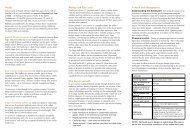Bushland Weeds Manual - Environmental Weeds Action Network
Bushland Weeds Manual - Environmental Weeds Action Network
Bushland Weeds Manual - Environmental Weeds Action Network
You also want an ePaper? Increase the reach of your titles
YUMPU automatically turns print PDFs into web optimized ePapers that Google loves.
20<br />
Chapter 3 Grass <strong>Weeds</strong> Case Studies<br />
grass weeds. It didn’t. Silver Grass<br />
cover remained low throughout the<br />
three year trial period, as did cover<br />
of Silvery Hairgrass.<br />
In contrast, Annual Veldgrass<br />
seedlings are susceptible to<br />
Fusilade ® (Davies 1997, Brown<br />
unpublished data) and like Wild<br />
Oat, germination is in the few weeks<br />
following the opening rains (Davies<br />
1997). Like Wild Oat, two years of<br />
treatment appeared to exhaust the<br />
soil seedbank of Annual Veldgrass<br />
at the site. However, there was an<br />
indication that a single treatment<br />
could result in Annual Veldgrass<br />
becoming a serious weed in the<br />
absence of Wild Oat competition.<br />
Non-grass weeds: In total, there<br />
were 12 weeds present at the site,<br />
including the Wild Oat and Blowfly<br />
Grass - none were invasive<br />
perennials. Only Flatweed<br />
(Hypochaeris glabra) and Ursinia<br />
(Ursinia anthemoides) showed a<br />
noticeable response to the removal<br />
of Wild Oat and Blowfly Grass. The<br />
number of Flatweed plants<br />
increased within the treatment plot<br />
by over 30 % from 1999 to 2001, but<br />
decreased in the control by 80 %.<br />
This suggests Flatweed has a<br />
stronger competitive advantage<br />
than the native annual flora, but is<br />
weaker against Wild Oat and<br />
Blowfly Grass, especially in poor<br />
years when moisture is scarce.<br />
The native flora<br />
As the 1999 season unfolded, colour<br />
erupted in the sprayed plot (Figure<br />
2). A mass flowering of native<br />
annuals occurred. These species,<br />
while found in the unsprayed plot,<br />
were largely smothered there by<br />
Wild Oat and Blowfly Grass.<br />
Native annual and perennial<br />
herbs: There was little indication<br />
that the Fusilade ® harmed the native<br />
annual and geophyte flora. The<br />
decrease in competition from Wild<br />
Oat and Blowfly Grass appears to<br />
have benefited the geophyte lifeform<br />
over time. Initially geophyte<br />
numbers were significantly lower in<br />
the treatment plot, but, after two<br />
years of treatment, numbers were<br />
similar in both plots.<br />
Two native annual herbs apparently<br />
affected by the density of Wild Oat<br />
and Blowfly Grass were Waitzia<br />
acuminata and Phyllangium<br />
sulcatum. Both species decreased in<br />
the control plot over the three<br />
years and remained similar<br />
(P. sulcatum) or increased<br />
(W. acuminata) in the treatment plot.<br />
Native grasses: Mature clumps of<br />
eight native grasses (Aristida<br />
contorta, Austrodanthonia<br />
caespitosa, Austrodanthonia setacea,<br />
Austrostipa elegantissima,<br />
Austrostipa tenuifolia, Austrostipa<br />
trichophylla, Eriachne ovata,<br />
Neurachne alopecuroidea) suffered<br />
only temporarily from the herbicide<br />
treatment. Seedling recruitment<br />
observed in 2001 suggests that the<br />
removal of competition by Wild Oat<br />
and Blowfly Grass will allow native<br />
grasses to become more dominant<br />
over time.<br />
Figure 2. Looking back over the treatment plot in October 1999 - a profusion of wild flowers.<br />
Herbicide treatment appeared to<br />
inhibit flowering in the native<br />
grasses. Aristida contorta and<br />
N. alopecuroidea in particular<br />
flowered profusely outside the<br />
treatment plot, while flowers were<br />
all but absent on tussocks inside<br />
the plot. A reduction in flowering of<br />
native grasses after Fusilade ®<br />
treatment has also been recorded in<br />
a study by Hitchmough et al. (1994).<br />
Although this and other studies<br />
(Hitchmough et al. 1994, Davies<br />
1997) indicate mature native<br />
grasses only suffer temporary<br />
adverse effects to Fusilade ®<br />
treatment, impacts need to be<br />
carefully monitored. Fusilade ® is<br />
highly phytotoxic at the 3-5 leaf<br />
stage on most native grasses tested<br />
(Hitchmough et al. 1994). The<br />
continued treatment of an area may<br />
inhibit recruitment of native grasses<br />
and inevitably lead to a reduction in<br />
native grass cover and local<br />
diversity.<br />
Direct seeding trials<br />
The aim of the direct seeding trial<br />
was to tip the competitive balance<br />
in favour of the native flora. Exotic<br />
grasses were controlled with the<br />
early herbicide treatment and the<br />
native seedbank was boosted by<br />
direct seeding with locally collected<br />
native herb and grass species. The<br />
direct seeding trial plot was both<br />
species-poor and had low cover and<br />
numbers of native plants. Following<br />
the direct seeding of native herbs<br />
and grasses in August 2000 there<br />
was no significant, or indeed<br />
obvious, increase in these figures.<br />
The failure of the sown seeds to<br />
germinate can be attributed to a<br />
number of factors. Although the<br />
seeds were viable, the dry winter<br />
and lack of soil moisture may have<br />
inhibited germination. Large<br />
amounts of seed may have blown<br />
away. It is important to note that<br />
any sort of soil disturbance that<br />
may have enhanced germination of<br />
broadcast seed would also enhance<br />
weed invasion. Time of sowing, seed<br />
treatment and lack of surface<br />
preparation may all be wholly, or<br />
partly responsible. It is possible<br />
that the site itself did not favour the<br />
germination of annual herbs; there<br />
were very few areas of bare soil<br />
within the plot. Further research<br />
into direct seeding in these<br />
woodlands is clearly required.



